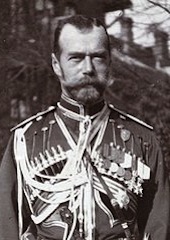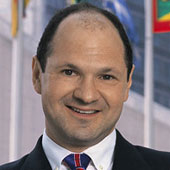1913-2013: How Russia Botched an Entire Century
Could Russia have been as successful as the United States?
September 5, 2013

One hundred years ago, shortly before the Bolsheviks seized power in 1917, Russia was on the verge of becoming the China of the day. It had embarked on the path to industrial capitalism two or three decades after the United States and Germany.
By the start of World War I, it was developing dynamically enough to get on track to catch up with the leading industrial powers of the day.
The Russia of that era was an enormous country, even larger than the Soviet Union at its peak, because it included both Poland and Finland within its borders. It also boasted tremendous natural resources and a vast, diversified population.
Russia featured remarkably modern elements. For example, it abolished serfdom in 1861, two years before President Lincoln’s Emancipation Proclamation in the United States.
In the countryside, a class of prosperous peasants was emerging. And in Russia’s southern provinces and in Ukraine, there were large, productive farms — similar to those later found in the American Midwest.
These farms made Russia the breadbasket of the world, accounting for around one-third of the global wheat trade before World War I. In fact, Russia’s early 20th century wheat traders were so sophisticated that they initiated hedging prices and used financial markets in London and New York for their crops.
In the Donetsk region in eastern Ukraine, coal and steel production was expanding, also using British investment and knowhow.
The construction of the Trans-Siberian railway, inaugurated in 1890, linked European Russia with the Pacific Coast. This made the economic development and exploration of Siberia possible, a move from which even today’s Russia benefits most handsomely.
Lagging literacy
At the same time, Russia’s educational system was poor. Around 70% of the population was still illiterate at the start of the 20th century. However, the illiterate were mainly peasants. In cities, primary and secondary schools were being established, benefiting even the urban poor.
Russia also had very modern universities and a substantial scientific research establishment. Mathematician Nikolai Lobachevsky pioneered hyperbolic geometry and chemist Dmitri Mendeleev is credited with creating the first periodic table of elements, both in the 19th century.
Russian physiologist Ivan Pavlov was the fourth winner of the Nobel Prize for Medicine in 1904, followed by immunologist Ilya Mechnikov in 1908. No Russian has won the prize since.
Professional and technical education, too, was increasingly open to children of lower-ranking officials, workers and even peasants. The ranks of the Russian intelligentsia, the educated class, were swelling. By the start of World War I, the literacy rate rose to 40%.
Despite lagging behind in terms of literacy, Russia managed to develop world-class culture and arts. Tolstoy and Dostoyevsky were probably the most internationally famous and influential fiction writers of their time.
Chekhov’s plays shaped the development of theater throughout the 20th century and Gorky’s plays were performed all over Europe in the years before World War I.
Stanislavsky developed an acting method that is still widely used in Hollywood. The Actors’ Studio and Lee Strasberg, who trained some of the brightest stars of American theater and cinema in the middle of the 20th century, adapted it.
Meanwhile, Stravinsky, Prokofiev and Shostakovich were at the origins of modern classical music, and Diaghilev’s Ballet Russe created modern dance.
In 1913, the Armory Show became a major sensation in New York City. It brought the French post-impressionist art of Van Gogh, Gauguin and others to America for the first time. While Americans were just catching on to these trends, Russian artists had already moved beyond post-impressionism.
Just two years later, in 1915, Kazimir Malevich created his Black Square, the first abstract painting.
An economic boom
While it is hard to assess economic growth in the early 1900s — few institutions collected data back then, any available figures were notoriously unreliable and modern statistical tools had not yet been developed — there is evidence that Russia stormed into the modern era after 1905.
There was rapid urbanization, with men increasingly moving to towns in search of employment. The share of the agricultural sector fell from 58% of the economy in 1885 to 51% before World War I.
Meanwhile, industry, construction and transportation accounted for 32% of the Russian economy, up from 23% in 1885. The rail network increased from 2,000 km to 70,000 km.
Like all rapidly developing nations, including the United States shortly before, Russia was a huge user of foreign capital. In the final decades of the czars’ rule, foreign investment accounted for 40% of all industrial investment, and a substantial portion of agricultural investment as well.
Western Europe, notably England, France and Belgium, provided most of that capital. By the start of World War I, Russia accounted for 15% of all international debt.
Even though Russia was still an underdeveloped country by prevailing Western European standards, it was not as backward as it is commonly portrayed. Just look at Russia’s performance in World War I, when it confronted Europe’s leading industrial power, Germany.
At the start of the conflict, Russia was not only able to mobilize quickly. It also managed to deliver troops and supplies to the front fast enough to start an invasion of Galicia in September 1914.
In fact, Russia was able to help its Western allies by forcing Germany to divert forces out of France in order to use them to assist Austria-Hungary, which was reeling from Russia’s assault.
In World War I, Russians certainly were outmatched by German efficiency and military technology. But the czar’s troops held up a lot better than Stalin’s Red Army did in the summer of 1941.
Soviet failures
After the Bolshevik revolution, the introduction of the command economy did manage to mobilize the Soviet Union. Later on, by channeling much of the country’s immense resources into the military-industrial complex, the communists were able to defeat Nazi Germany. Thereafter, they were able to come close to matching American military prowess for around half a century.
But such a gigantic effort could not be sustained. To get close, the Soviet government wasted and destroyed much of the resources on which Russia’s economic success relied.
First and foremost, it squandered Russia’s human resources. Russia’s population is currently around 140 million. Some demographers believe that natural growth since 1913 should have put its population to almost 200 million or even 225 million.
Two World Wars, fought by Russian commanders without regard for losses, two famines in the early 1920s and the 1930s, purges and social ills brought about by communist mismanagement have resulted in as many as 85 million in today’s Russia “going missing” — not being born at all.
The communists did create a good educational system and achieved nearly 100% literacy, but they managed to waste human capital in other ways. Peasants were herded into collective farms, effectively reintroducing serfdom.
Life expectancy for men in Russia now is an extremely low 64.3 years — on a par with or less than in many countries in Sub-Saharan Africa. Chronic illnesses and alcoholism that often precede an early death rob society of the most productive years of its males.
Moreover, the economic system that prohibited private enterprise kept several generations of Russians from fulfilling their potential and benefiting society as a whole.
While pre-revolutionary Russia was developing into a major global economic power naturally and consistently, the USSR was a colossus with feet of clay.
Today’s Russia still suffers from the disastrous legacy of the Soviet era. Instead of co-leading the world, as its potential suggested at the start of the 20th century, it is, on average, one of the poorest and technologically backward countries in Europe.
In a 19th century kind of way, Russia produces little and survives by selling its vast array of raw materials to the world’s leading industrial nations.
With that as economic strategy, the country itself exists in a serf-like state. The raw material riches benefit small, kleptocratic elites, who shift their assets abroad. Considerable parts of the country’s infrastructure are as if they dated back to the medieval era. Social services are rudimentary and the quality of life is extremely poor.
The United States has spent much of the past 100 years relentlessly developing, perfecting its industrial base and its technological infrastructure and investing into human capital. It has focused on creating optimal conditions for individuals to achieve their potential.
Despite various mistakes and setbacks, the United States still sets the direction of technological innovation and its culture dominates the world.
Russia, in contrast, has wasted its resources, especially human ones. It literally killed off many talented people. Others were able to escape in time and achieved fame in Europe and, especially, in the United States, thus contributing notably to America’s economy and culture.
Choreographer George Balanchine, writer Vladimir Nabokov and, most recently, Google founder Sergei Brin are just a few examples among many.
Russia’s political economy has not moved forward much over the past 100 years. Despite mind-boggling mistakes, mismanagement and crimes of its leaders, Russia even now has much unrealized potential.
Russians may yet rise up and fulfill their human potential. But for that to happen, they will need to change the country’s kleptocratic political system and end their own serf-like mentality. Both are, in so many ways, the direct descendants of the Soviet era.
Alexei Bayer is a contributing editor of The Globalist. His debut novel, Murder at the Dacha, which is set in 1960s Moscow, was published in May.
Takeaways
A century ago, before the Bolshevik Revolution in 1917, Russia was on the verge of becoming the China of the day.
Pre-revolutionary Russia was developing into a major global economic power naturally and consistently.
Russia had abolished serfdom in 1861, 2 years before President Lincoln's Emancipation Proclamation in the US.
Russia still suffers from Soviet legacies. It is among the poorest & technologically backward European states.
In a serf-like state, Russia's raw material riches benefit small, kleptocratic elites, who shift assets abroad.
Russia has wasted its resources, especially human ones. It literally killed off many talented people.
Russia has been driven into the ground, but even now it has much unrealized potential and may yet rise up.
To meet its potential, Russia will need to change its Soviet-inherited kleptocratic political system.
Read previous

Obama’s Amateur Hour
September 5, 2013
